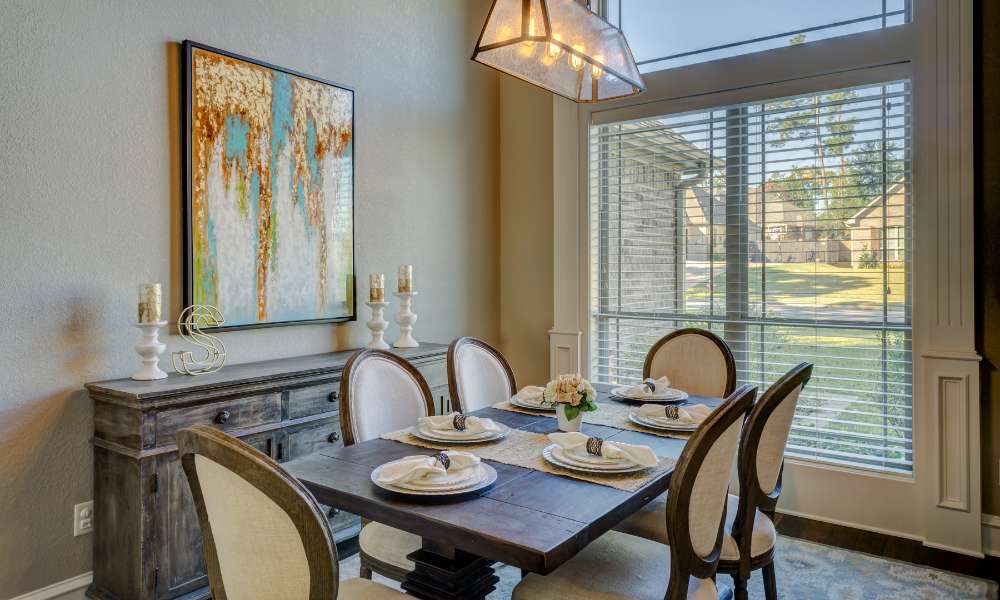When designing a dining room, one crucial aspect often overlooked is the height of the dining table. The right table height ensures comfort and enhances the dining experience, allowing for better interaction and ease of use. This article will explore the ideal dining table height, the factors that influence it, and guidelines to help you choose the perfect height for your dining space. Whether you are purchasing a new table or customizing one, understanding the importance of table height will ensure a harmonious and comfortable dining environment.
1. Standard Dining Table Height Overview
The standard dining table height typically ranges between 28 to 30 inches, which is considered the optimal height for most dining activities. This height allows for comfortable seating and sufficient legroom, accommodating a variety of chair styles and sizes. Ensuring that your eating table falls within this range can greatly enhance the overall dining experience, providing both functionality and aesthetic appeal. When selecting or designing an eating table, it is important to consider this standard height to maintain consistency and comfort. This ensures that all guests can enjoy their meals without any discomfort or awkwardness, making the dining experience more enjoyable.
2. Factors Affecting Dining Table Heights
Several factors can affect the ideal height of an eating table, including the height of the chairs, the average height of the users, and the intended use of the table. For instance, if the chairs have thick cushions, the table might need to be slightly lower to maintain a comfortable sitting posture. Similarly, taller individuals might prefer a table on the higher end of the standard range, while shorter individuals might find a lower table more comfortable. The intended use of the table also plays a role; a table primarily used for casual dining might have different height requirements compared to one used for formal dinners or multi-purpose activities like working or studying. Considering these factors ensures that the eating table elevation is tailored to meet specific needs, enhancing comfort and usability.
3. Measuring Ideal Dining Table Height
Measuring the ideal dining table height involves a few straightforward steps to ensure maximum comfort and functionality. Start by measuring the height of the chairs from the floor to the seat. A general rule of thumb is to leave about 10 to 12 inches of space between the seat and the tabletop to accommodate legroom comfortably. Next, consider the thickness of any cushions on the chairs, as this can affect the overall seating height. If the table is for a mixed-use space, factor in additional activities that might require a different height for optimal comfort. Using these measurements, you can determine the best elevation for your eating table, ensuring it fits well with your existing chairs and meets your specific needs. This approach guarantees an eating setup that is both comfortable and practical for daily use.
4. Height: Industry Standards
Industry standards for dining table height typically range between 28 to 30 inches from the floor to the tabletop. This range is considered optimal for providing a comfortable dining experience for most people. Adhering to these standards ensures that the table height complements standard chair heights, which usually measure between 17 to 19 inches from the floor to the seat. These industry standards are established to promote ergonomic seating and to accommodate a variety of dining activities, from casual meals to formal dinners. When selecting or designing an eating table, following these height guidelines can help create a balanced and comfortable eating space that meets universal usability and comfort criteria.
5. Comfortable Heights Explained
Comfortable dining table heights are crucial for an enjoyable dining experience, typically falling between 28 and 30 inches. This elevation range ensures that diners can sit comfortably with adequate legroom and that their arms can rest naturally on the tabletop. When the table elevation is within this range, it promotes good posture, reduces strain on the back and shoulders, and facilitates easy conversation and interaction among diners. Additionally, this height complements standard chair heights, allowing for a harmonious and ergonomic seating arrangement. By prioritizing comfort in eating table heights, you create a dining environment that enhances the overall dining experience, making meals more enjoyable and gatherings more pleasant.
6. Choosing the Right Height for Dining
Choosing the right height for an eating table involves considering various factors to ensure comfort and functionality. Start by assessing the elevation of your eating chairs, as the ideal table elevation should allow about 10 to 12 inches of space between the chair seat and the tabletop. This space ensures sufficient legroom and a comfortable seating position.
Additionally, consider the elevation of the people who will use the desk regularly. For taller individuals, a slightly higher table might be more comfortable, while shorter individuals might prefer a table on the lower end of the standard range. Also, think about the table’s primary use – whether it will be used for casual dining, formal dinners, or multi-functional purposes like working or studying. By taking these aspects into account, you can choose an eating desk height that provides optimal comfort and meets your specific needs.
7. Adjustable: Pros and Cons
Adjustable dining tables offer a versatile solution for various dining needs, providing several pros and cons. One of the main advantages is their flexibility; you can easily modify the desk elevation to accommodate different activities, such as dining, working, or crafting. This makes them ideal for households with diverse needs or limited space. Adjustable tables also cater to people of different heights, ensuring everyone can find a comfortable setting. However, there are some downsides to consider. Adjustable mechanisms can add complexity and potential maintenance issues over time. Additionally, these tables might be more expensive than fixed-height options, and the design might not always match traditional aesthetics. Weighing these pros and cons can help you decide if an adjustable eating desk is the right choice for your home.
8. Impact of Chair Height on Dining
Chair height significantly impacts the overall dining experience, influencing comfort and functionality. The ideal chair elevation typically ranges from 17 to 19 inches from the floor to the seat, allowing for proper alignment with standard eating desk heights of 28 to 30 inches. When the chair elevation is well-matched with the table, it ensures that diners can sit comfortably with their feet flat on the floor and their arms resting naturally on the desk. An improper chair elevation can lead to discomfort, poor posture, and an awkward dining experience. Additionally, the height of the chair’s elevation backrest and the presence of cushions can also affect seating comfort. Ensuring that chair height complements the table height elevation is crucial for creating a harmonious and ergonomic eating setup that enhances the overall enjoyment of meals and gatherings.
9. Height for Small Spaces
Selecting the right dining desk height for small spaces requires careful consideration to maximize comfort and functionality. In compact areas, a standard eating table elevation of 28 to 30 inches remains ideal as it ensures ergonomic seating and sufficient legroom. However, the table’s design and shape become crucial in small spaces. Opting for a sleek, minimalist design or a round desk can save space and improve traffic flow around the eating area. Multi-functional tables that can be adjusted or extended offer flexibility, making them perfect for small apartments or dining nooks. Additionally, consider chairs that can be tucked neatly under the desk when not in use to free up space. By focusing on these aspects, you can create a comfortable and efficient eating area, even in the coziest of spaces.
10. Ergonomic Height Guidelines
Ergonomic dining table height guidelines are essential for ensuring comfort and promoting good posture during meals. The standard elevation for most eating tables is between 28 to 30 inches, which aligns well with chair heights of 17 to 19 inches from the floor to the seat. This combination allows diners to sit with their feet flat on the ground and their arms at a comfortable angle on the tabletop, reducing strain on the back and shoulders. When designing or choosing an eating desk, it’s important to consider these guidelines to accommodate people of various heights and sizes. Additionally, ensuring that there is adequate space between the desk and the chairs—usually around 10 to 12 inches—provides enough legroom for all diners. By adhering to these ergonomic principles, you create a dining environment that enhances comfort, reduces discomfort, and encourages better posture during meals.
11. Customizing Dining Table Height Tips
Customizing eating table height can enhance comfort and functionality, making the dining experience more enjoyable. To start, consider the elevation of your chairs and ensure there is about 10 to 12 inches of space between the chair seat and the tabletop for adequate legroom. If your chairs have cushions or are higher than standard, adjust the table elevation accordingly. For taller individuals, a desk height closer to 31 inches might be more comfortable, while shorter individuals might prefer a height around 27 inches. Additionally, think about the primary use of the table—whether it’s for casual dining, formal dinners, or multi-purpose activities like working or studying. Customizing the desk elevation based on these factors ensures a tailored fit that meets specific needs, enhancing both comfort and usability in your dining space.
12. Height Trends
Dining desk height trends have evolved to emphasize both functionality and style, reflecting modern living needs. Recently, there has been a growing preference for tables that can easily transition between casual and formal settings, with adjustable elevation options becoming increasingly popular. These tables offer versatility, allowing users to adapt the elevation for different occasions and activities, from everyday meals to hosting dinner parties.
Additionally, the trend towards open-concept living spaces has influenced the design of eating tables, with many opting for sleek, minimalist designs that seamlessly blend with the overall décor. Taller bar-height tables and counter-elevation tables are also gaining popularity in contemporary homes, providing a more relaxed and social dining experience. These trends highlight the importance of flexibility and adaptability in eating desk design, catering to diverse lifestyles and preferences while maintaining comfort and aesthetic appeal.
13. Comparing Round vs Rectangular Heights
When comparing round versus rectangular eating table heights, it is essential to consider both the practical and aesthetic implications. Round tables, typically set at the standard height of 28 to 30 inches, promote a sense of intimacy and facilitate easier conversation among diners due to the lack of corners. This shape is particularly well-suited for smaller spaces as it allows for better flow and can often seat more people in a compact area. On the other hand, rectangular tables also adhere to the standard elevation range but offer more versatility in terms of seating capacity and arrangement.
They are ideal for larger eating rooms or spaces that host frequent gatherings, providing clear lines and more surface area for serving dishes. The choice between round and rectangular tables ultimately depends on the specific needs of your eating space, including the available area, the number of diners, and the desired ambiance. Both shapes, when chosen at the appropriate height, can enhance the dining experience by ensuring comfort and usability.
Final Thoughts
Dining table heights highlight the importance of choosing the right elevation height to ensure a comfortable and enjoyable dining experience. Standard eating table heights of 28 to 30 inches are designed to accommodate a wide range of chairs and users, promoting good posture and ease of use. However, individual preferences and specific needs may require adjustments, whether through customizable or adjustable tables. Considering factors such as chair elevation, user height, and the table’s primary function can help tailor the dining setup for optimal comfort and functionality. Whether you prefer a round desk for its intimacy and space-saving qualities or a rectangular desk for its versatility and larger capacity, ensuring the correct elevation is key. By paying attention to these details, you can create an eating space that is both practical and inviting, enhancing every meal and gathering.





